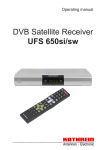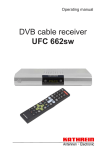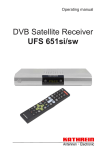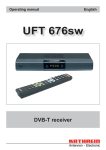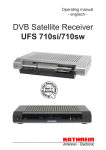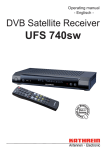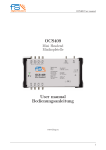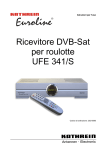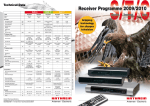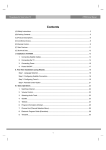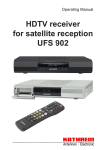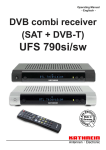Download 9363469a, Operating manual DVB Satellite Receiver UFS
Transcript
Operating manual DVB Satellite Receiver UFS 640si PREFACE Dear customer, This operating manual is intended to help you make the fullest use of the extensive range of functions offered by your new satellite receiver. We have tried to make the operating instructions as easy as possible to understand, and to keep them as concise as possible. To help you understand particular specialist terms that cannot be translated, we have added a short glossary at the end of the manual. The power switch is an environmentally friendly feature. If you will not be using your receiver for an extended period, you should use the power switch to disconnect it from the power supply and save energy. For shorter breaks, you can use the remote control to switch the receiver to standby, which uses only a minimal amount of energy. We wish you good reception and much pleasure using your new DVB satellite receiver. Your KATHREIN team 2 IMPORTANT INFORMATION The channels available on the satellites and transponders are subject to continual change. If changes do occur, the new channels have to be set in the receiver because the factory preset programming corresponds to the status on the date of manufacture. The information for these settings can be found on the Internet or in relevant magazines. Your receiver is equipped in the factory with the latest software version at that time. We are, however, constantly working on adapting the software to the wishes of our customers and to developments in technology. The “Service Menu” section provides more information on this. The information in this operating manual was correct at the time of going to press. We reserve the right however to make changes at any time and without prior notice. If new software is released for your receiver, and this affects the information in the operating manual (e.g. changes to the menus and/or functions), if we believe it necessary we will make available a new operating manual for download under “www.kathrein.de”. Please keep the original packaging in case you need to return the product at any time. If the product is not properly packed, the warranty claim is invalidated. Make a note of the receiver's basic settings, so as to be able to restore them if necessary! Before you switch off your receiver with the mains switch, you must first switch it into stand-by mode by pressing the stand-by button on your remote control. This ensures that modified and new data are saved to the receiver. As soon as the receiver is in stand-by mode, it can be switched off completely using the on/off switch on the receiver front panel. Do not press the on/off button when the receiver is in operation! This can lead to loss of data or damage to software. The term DiSEqC™, which appears in this user manual, is a registered trademark of the European Telecommunication Satellite Organization (EUTELSAT). INFORMATION ON AUDIO MPEG INC. AND S.I.SV.EL, S.P.A: This unit makes use of legally protected technologies, which are protected by patents in the USA and also by other intellectual property rights in other countries. KATHREIN-Werke KG has obtained licences from Audio MPEG Inc. and Societa‘ Italiana per lo sviluppo dell‘elettronica, S.I.SV.EL, S.P.A to use these technologies. These licences carry certain restrictions, which apply also to you as the customer. Accordingly this unit may be used by the end customer only for private non-commercial purposes and for the licensed content. It may not be used for commercial purposes. The use of products or processes that are sold or used with this unit is not included in this statement. The use of reverse engineering is not permitted in respect of the licensed technologies, nor is disassembly. DISPOSAL INSTRUCTIONS Electronic equipment is not domestic waste - in accordance with directive 2002/96/EC OF THE EUROPEAN PARLIAMENT AND THE COUNCIL dated 27th January 2003 concerning used electrical and electronic appliances, it must be disposed of properly. At the end of its service life, take this unit for disposal to an appropriate official collection point. Spent batteries are special waste! Do not throw spent batteries into your domestic waste; take them to a collection point for spent batteries. 3 CONTENTS PREFACE ................................................................................................................................. 2 IMPORTANT INFORMATION ...................................................................................................... 3 CONTENTS ............................................................................................................................... 4 SAFETY INSTRUCTIONS - IMPORTANT NOTES ........................................................................ 6 RECEIVER FEATURES / DELIVERY SCOPE ............................................................................... 7 CONTROLS, DISPLAYS AND CONNECTIONS ............................................................................ 8 CONNECTION AND SET-UP ...................................................................................................... 9 UNDER-SHELF MOUNTING .................................................................................................... 11 MOUNTING ON A FIXED EVEN SURFACE ............................................................................... 11 REMOTE CONTROL ................................................................................................................ 12 FIRST INSTALLATION ............................................................................................................. 13 OPERATING INSTRUCTIONS .................................................................................................. MENU CONCEPT .................................................................................................................. MENU TREE ......................................................................................................................... ALPHANUMERIC INPUTS ...................................................................................................... LANGUAGE SETTING - OSD .................................................................................................. 29 29 30 31 31 ON-SCREEN DISPLAYS (OSD) ................................................................................................ CHANNEL MESSAGES .......................................................................................................... CHANNEL INFORMATION ...................................................................................................... CALLING UP THE OPTIONS CHANNEL .................................................................................. OPTION SELECTION ............................................................................................................. ERROR SIGNALLING ............................................................................................................ CHANNEL LIST – TV/RADIO................................................................................................... 32 32 32 32 33 33 33 EPG - ELECTRONIC PROGRAMME GUIDE .............................................................................. CALLING UP THE EPG .......................................................................................................... “CURRENT” VIEW ................................................................................................................. “PREVIEW” VIEW (PROGRAMME LISTINGS) .......................................................................... ADDITIONAL INFORMATION (i BUTTON) ................................................................................ RECORDING (TIMER)............................................................................................................ 35 35 36 37 38 39 40 40 41 42 RECORD ONCE ................................................................................................................... RECORD DAILY ................................................................................................................... RECORD WEEKLY ............................................................................................................... PLAN RECORDING ............................................................................................................... VIDEOTEXT (TELETEXT)......................................................................................................... 43 EDIT CHANNEL LIST............................................................................................................... 44 SELECTION OF THE LIST / CHANNELS TO BE EDITED .......................................................... 44 EDITING LISTS / CHANNELS ................................................................................................. 45 “LAST FUNCTION” MEMORY .................................................................................................. MOVE CHANNELS ............................................................................................................... DELETE CHANNELS ............................................................................................................. SKIP CHANNELS ................................................................................................................. LOCK CHANNELS ................................................................................................................ COPY CHANNELS TO THE FAVOURITES LIST ........................................................................... START BLOCKSELECTION (HIGHLIGHTING SEVERAL CHANNELS) .............................................. 4 46 46 46 46 47 47 47 CONTENTS EDIT FAVOURITES LISTS ...................................................................................................... 48 REMOVE FROM THE FAVOURITES LIST .................................................................................. LOCK CHANNELS ................................................................................................................ 48 49 RENAME FAVOURITES LIST .................................................................................................. 49 START BLOCKSELECTION (HIGHLIGHTING SEVERAL CHANNELS) .............................................. 49 SEARCH CHANNELS (CHANNEL SEARCH)............................................................................. AUTOMATIC (CHANNEL) SEARCH ......................................................................................... MANUAL (CHANNEL) SEARCH .............................................................................................. CHANNEL SEARCH WITH SERVICE ID .................................................................................. 50 50 52 54 PARENTAL CONTROL............................................................................................................. LOCKING MAIN MENU .......................................................................................................... LOCK SET-TOP-BOX ............................................................................................................. DEFINE NEW PIN CODE........................................................................................................ 56 56 56 57 SETTINGS .............................................................................................................................. TV SETTINGS (TV, PICTURE AND SOUND) ............................................................................ CUSTOMIZE SCREEN MENU ................................................................................................. DATE AND TIME .................................................................................................................... COMMON INTERFACE .......................................................................................................... ANTENNA CONFIGURATION ................................................................................................. 58 59 60 61 61 61 SERVICE MENU ...................................................................................................................... 62 UPDATING SOFTWARE ......................................................................................................... 62 RESTORE FACTORY SETTINGS ............................................................................................ 64 CONNECTING UP THE VIDEO/DVR ......................................................................................... 65 RECORDING ......................................................................................................................... 65 PLAYBACK............................................................................................................................ 65 USING THE FRONT PANEL/SERVICE ...................................................................................... 66 TECHNICAL APPENDIX........................................................................................................... FEATURES ........................................................................................................................... SCART SOCKET ASSIGNMENT ............................................................................................. VHS/S-VHS SWITCHING........................................................................................................ CONNECTION EXAMPLE....................................................................................................... EXAMPLES OF single-cable systems ....................................................................................... 67 67 69 69 70 71 SHORT TECHNICAL GUIDE .................................................................................................... 74 GLOSSARY ........................................................................................................................... 76 TROUBLESHOOTING.............................................................................................................. 77 FOR YOUR NOTES ................................................................................................................. 78 5 SAFETY INSTRUCTIONS - IMPORTANT NOTES 6 RECEIVER FEATURES / DELIVERY SCOPE The UFS 640 is suitable for the reception of digital satellite TV and radio programmes. The HDMI interface allows one to connect the receiver to the HDMI interface on a suitable flat-screen TV for optimal viewing comfort. An integrated upscaler ensures optimal picture processing for flat-screen TVs. The receiver is supplied with an external power supply unit which allows the user to operate it on both 230 V and 12 V, as well as the accessories required for on-surface or under-shelf installation. A variety of features include: Kathrein EPG, guided first installation with national programme lists, electrical audio output for Dolby Digital (AC 3), a video Cinch output and videotext with 800-page memory capacity. The receiver is available in silver. DELIVERY SCOPE - UFS 640si Remote control RC 671 Scart cable 2 batteries, AAA 1.5 V IR sensor 230 V/12 V power supply unit 12 V connection cable with shock-proof plug (cigarette lighter and 12 V connection plug) Mounting support User manual Safety notes DISPLAY OF ANTENNA SIGNAL LEVEL AND EMISSION OF SEARCH TONE (SAT FINDER) ON THE TV SET Initial installation must first be completed before you can use the search tone to align the antenna. -Taste to access the main menu and press the !-button for three seconds to activate the search tone. On the screen, you will then be able to Press the see the menu “antenna configuration” where the bars signal strength and signal quality are displayed. At the same time, the receiver will display the current signal strength (available at the receiver input). The higher the tone, the better the signal strength. Press the -Taste button to switch off the tone and exit the menu.. 7 CONTROLS, DISPLAYS AND CONNECTIONS This section provides a brief description of all the controls, displays and connections. VIEW OF FRONT PANEL (FLAP REMOVED) VIEW OF REAR PANEL Front Panel Controls and Displays Rear Panel Controls and Displays 1. 2. 3. 1. 2. 3. 4. 5. 6. 8 On/Off switch (with mains disconnect) Channel select buttons - (▼▲) Display LNB loop-through input LNB input HDMI output Scart socket for VCR/AUX connection Video output (composite colour) Electrical data stream output (SPDIF/Sony Philips Digital Interface Format) for Dolby Digital AC 3 audio 7. Audio outputs (L/R) - cinch sockets 8. Scart socket for TV connection 9. RJ 11 data interface / connection port for an external IR sensor 10. Mains power cable CONNECTION AND SET-UP The following section is intended specifically for specialist dealers. You need not refer to this section unless you are carrying out the installation yourself. The “Connection examples” section provides a sample configuration. Do not connect the receiver to the power supply until all installation work has been properly carried out. Refer to the information in the “Safety instructions” section. CONNECTING THE UNIT (SAT-IF CONNECTIONS) Connect the Sat IF input on the receiver to the satellite reception system. Use a coaxial cable with a standard F connector. If the F standard connectors are not yet fitted on the cables, strip the insulation from the cables as shown in the following illustration and carefully screw the F standard connectors on to the ends of the cables until they are securely seated. When fitting the connector, make sure that no wires from the braid are touching the inner conductor, so no short circuit can occur. The quality of the reception signal depends on this connection. RECEPTION REQUIREMENTS Make sure that your own satellite antenna system is equipped at least with a universal LNB for digital reception in the high-band range. RECEPTION SYSTEM PRESETS The presets for the control signals have been made for standard reception systems, i.e. 14/18 V for polarity reversal and 22 kHz switching signal for low/high band changeover on multi-feed reception systems. 9 CONNECTION AND SET-UP TV AND VIDEO RECORDER CONNECTION Connect the satellite receiver (TV Scart socket) and the TV set using a Scart cable (see “Connection Example”). If your TV has a stereo capability, you can receive the sound in stereo via the Scart connection. Use a further Scart cable to connect the satellite receiver (VCR/Scart socket) to the video recorder/DVR. For system reasons, the same video signals are to be found at the TV Scart socket as at the video cinch output. If you are recording using an external video recorder, remember not to operate the receiver during recording, otherwise all the on-screen displays will appear on your recording. AUDIO CONNECTION If you want to play the sound on your hi-fi system, connect the audio cinch sockets to the input sockets on the hi-fi system, using an appropriate cable (see “Connection Example”). ELECTRICAL DIGITAL OUTPUT The electric digital output is intended for the connection of a Dolby Digital system (see “Connection Example”). INSERTING BATTERIES INTO THE REMOTE CONTROL Remove the cover on the rear of the remote control. Insert the two batteries supplied into the remote control. Ensure correct polarity of the batteries; the + and – markings as indicated inside the battery compartment. Slide the cover back into the housing until it locks in place. MOUNTING THE UFS 640SI WITH A MOUNTING SUPPORT The supplied mounting support enables you to not only place the receiver onto a firm, even surface but to fix it onto or below this surface (under-shelf installation). When selecting the place for installation, it is imperative that Section 1 “Safety Notes” be observed! Make sure that the connection sockets on the receiver rear are accessible and that there is enough room for the cables to be connected! 10 CONNECTION AND SET-UP UNDER-SHELF MOUNTING Remove the supplied wooden screws from the transportation fixing on the top of each fixing bracket (2 each). Fix both mounting brackets to your receiver as illustrated in the illustrations 1-3. The following is to be observed: 1. 2. Left(L) and right (R) markings (see arrows illustration 2) The notch spacings on the bottom side of the fixing brackets must be inserted into the first or last row of the ventilation slits on the top of the receiver (see arrows illustration 1) ↓↓↓ ↓ ↓ ↓ ↓ ↓ ↓ Now take the receiver with the mounting set hooked on to it and place it on the spot where the unit is to be mounted. Screw the supplied wooden screws into the 4 screw holes (see illustration no. 4). If possible, use the wooden screws included in the delivery scope. If this is not possible, other appropriate screws may be used. Do not under any circumstance use flat-head screws since these can damage the support (see illustration no. 5). Screw connection left right Afterwards, tighten all screws so that the mounting support does not move. To dismount at a later period of time, just loosen the four screws by one turn and then slide the receiver to the right (under-shelf installation) or to the left (on-surface installation) MOUNTING ON A FIXED EVEN SURFACE The mounting set can also be attached to the bottom of the receiver in order to prevent it from slipping or falling. Mounting is then effected in the same way as by under-shelf mounting; the only difference is that the mounting set is fixed onto the bottom of the unit. 11 REMOTE CONTROL ... Numeric input for channels, timers etc. ? Power on / stand-by Open the main menu, leave the menu and return to the TV picture Videotext (Teletext) Volume ! Access Channel Notification/Info " ' Sound on/off Channel selection up/down # FAV (red) Open favourites selection % OPT (yellow) $ PIP (green) Open channel options sound/subtitles selection “Current” view in the EPG Open EPG (Electronic Programme Guide) Leave the menu step by step Changing channel in the programme preview (EPG) (red) Recording in EPG, editing in channel list Currently not used The button symbols shown here can also be found in the description of the operating steps. 12 & TV/R (blue) Switch between TV/radio @ Cursor buttons Confirm entry open channel list Changing channel in the programme preview (EPG) Stop recording AV mode FIRST INSTALLATION: General Before using your receiver for the first time, read the “Safety Instructions” and “Connection and Setup” sections. The “Connection examples” section provides a sample configuration. Do not connect the receiver to the power supply until all installation work has been properly carried out. The guidance given in the “First Installation” section assumes that the receiver has been properly connected as per the “Safety Instructions” and “Connection and SetUp” sections. First switch your TV set on and select the AV channel slot. Switch on your receiver at the power switch at the front of the unit. The following display appears: Also pay attention to the bars at the bottom of the on-screen display! These provide information on what to do next. Select the menu language you want using the Italian, Spanish, Czech, Dutch and Turkish. buttons. Available options: German, English, French, Press the $ (green) button to move to the next menu. Note: If you are unsure whether you chose the right option from a previous menu, you can go back a step at any time during the first installation process by pressing the # (red) button. 13 FIRST INSTALLATION: General The following display appears: Use the buttons here to select whether you wish to use the pre-programmed channel list (select “no”) or generate a new channel list by searching (select “yes” - you will be asked later in the first installation to compile this list). Press the buttons to access the next line. buttons to select the country for which you wish to load the pre-programmed channel list (this is relevant only if you did not reject the pre-programmed channel list). Press the $ (green) button to move to the next menu. Use the The following display appears: Use the @ buttons here to select the settings for your TV set. When doing this, refer to the operating instructions for your TV set! TV format Select the TV's picture format. Either 4:3 or 16:9 14 FIRST INSTALLATION: General Picture format Here you select the type of screen display, depending on the setting of your TV format: - TV format “4:3”: Pan & Scan or Letterbox TV format “16:9”: “Automatic” or “Always 16:9” TV-Scart-Output Select the type of video signal at the TV Scart socket here. Select the signal that your TV set can process. - FBAS - composite colour signal or RGB - Red/Green/Blue signal HDMI format Here please select the format (resolution) that will be output at the HDMI socket. Select the resolution appropriate to your TV set. Available options: Auto (automatic format choice), 576p, 720p or 1080i Press the Use the options: - $ (green) button to move to the next menu. The following display appears: buttons here to select the setting to match your reception system. You have the following DiSEqC™1.0 Simple LNB or Single-cable system Now continue with the first installation chapter that applies to your reception system. When selecting the LNB type in the setting that applies to you, note that “Wideband” is available only for the “single-cable system” setting! 15 FIRST INSTALLATION: DiSEqC™1.0 When selecting the satellite(s), make sure that your reception position is aligned to the desired satellite(s)! buttons here to switch to the “Number of Satellites” selection Use the Number of Satellites Press the button to select the number of satellites to be received. You can select a number from one to four satellites to be received. The following display appears (example): buttons to select the first satellite slot. Press the button to open the menu for the satellite Use the settings. 16 FIRST INSTALLATION: DiSEqC™1.0 The following display appears (example): Satellite and Position Use the buttons to set the desired satellite (selection from 17 pre-programmed options). LNB settings Use the buttons here to select the LNB type used in your system. The choice is between “Universal” and “user-defined”. Universal: No further input is required, since all necessary frequency ranges are covered by a universal LNB. User-defined: If you choose not to use a universal LNB, you must here set the frequency ranges for which your LNB was configured. buttons to select the frequency range to be changed (low / high frequency). Use the buttons or the keypad to set the exact frequency for which your LNB was configured. Use the Test transponder To check whether the settings that you have made are correct, use the buttons to move to the “Test transponder” field. Use the buttons to select the required transponder from the various ones listed. If your settings are correct, you will see at the top right of the screen the live signal of a channel for the currently selected transponder. If you do not receive a signal, check your settings again and if necessary call for expert help. button to return You have now completed all settings for the first satellite. Press the to the “Satellite Selection Menu” and perform the settings in the same way for the remaining satellites. When you have finished configuring the satellite press PIP (green). The receiver then automatically calls up the selection menu for the channel search. Continue by selecting the item (“Perform channel search”). 17 FIRST INSTALLATION: Simple LNB Satellite and position Use the buttons to select the desired satellite whose signal is to be received by the tuner. have selected your desired satellite, use the buttons to switch to the selection of the “LNB When you Type”. LNB settings buttons here to select Use the the LNB type used in your system. The choice is between “Universal” and “userdefined”. Universal: No further input is required, since all necessary frequency ranges are covered by a universal LNB. User-defined: If you choose not to use a universal LNB, you must here set the frequency ranges for which your LNB was configured. Use the buttons to select the frequency range to be changed (low / high frequency). Use the buttons or the keypad to set the exact frequency for which your LNB was configured. LNB voltage Use the buttons to select whether your LNB is supplied with power from the receiver (“On”) or whether it has its own power supply (“Off”). Test transponder To check whether the settings that you have made are correct, use the buttons to move to the “Test transponder” field. Use the buttons to select the required transponder from the various ones listed. If your settings are correct, you will see at the top right of the screen the live signal of a channel from the currently selected transponder. If you are not receiving a signal, check your settings again and if necessary call for expert help. 18 FIRST INSTALLATION: One Cable buttons here to select “One cable” as the “System”. Press the Use the menu item. The following display appears: button to move to the next The various options for a single-cable system with Kathrein components are summarised at the end of this manual in the “Technical Appendix” section under “Examples of Single-Cable Systems”. Number of satellites buttons to select how many satellites (max. 2) you would like to receive with your reception system. Press the button to move to the next menu item. Use the Configure satellites Press the button to open the menu. The following display appears: Satellite and Position buttons to select the first satellite (satellite 1 of 2, depending on the setting), as shown on Use the the screen. LNB settings Use the buttons here to select the LNB type used in your system. The choice is between “Universal”, “Wideband” and “Single”. If in your reception system you use a single-cable LNB (e.g. UAS 481 from Kathrein), please select here the setting “Wideband”. If you use a single-cable matrix (EXU 908) or a single-cable changeover matrix (EXR 551 or EXR 552) from Kathrein, the LNB you use must be a “Universal LNB”! 19 FIRST INSTALLATION: One Cable Universal: No further input is required, since all necessary frequency ranges are covered by a universal LNB. Wideband: No further input is necessary, since all frequency ranges are set by the Wideband LNB. Single: If you are not using a Universal or a Wideband system, you must set the frequencies here. You can find the necessary information in the documentation supplied with your system. buttons to select the line “LNB Low Frequency”). Use the Use the set the exact frequency for which your LNB was configured. buttons or the keypad to When you have completed all setting for the currently selected satellite, press the button. If you have selected more than one satellite, repeat the previous ”Satellite and Position” and “LNB Type” processes for the number of satellites you selected. When you have completed the settings for all the satellites, the following display appears: Use the button to select the next menu item “New registration”, then press the The following display appears: button. Use the buttons to select the desired type of installation and confirm your selection using the button. For clarity, we have split further details into two sections. Firstly we give details of “Automatic” installation, then details of “Manual” installation. 20 FIRST INSTALLATION: Single-cable system (automatic) If one or more receivers are already present on the system and an additional receiver is to be connected, when assigning the transmission frequency for the new receiver make sure that no transmission frequencies are duplicated. No frequency can be used by more than one receiver. The receiver searches for the transmission channels on your single-cable system and shows in the next display the available transmission channels. Use the buttons to select the transmission channel you want and confirm the selection with the button. No frequency can be used by more than one receiver. The receivers would interfere with each other. The receiver now reads the existing system data for your single-cable system and configures itself. The receiver has been successfully registered on your single-cable system. Confirm the display $ button. Now press the (green) with the button. The receiver will automatically display the menu for the channel search. Continue with the item (“Perform channel search”). If no connection to the single-cable system could be established, you will receive the message “Registration was abortive!”. Check your settings and if necessary call for expert help. 21 FIRST INSTALLATION: single-cable system (manual) If one or more receivers are already present on the system and an additional receiver is to be connected, you must assign the new receiver a transmission frequency that is not already in use (otherwise the receivers will interfere with each other). Depending on the system to which they are connected, a maximum of four or eight receivers may be connected to a single-cable system (a twin receiver counts as two receivers) Connected equipment Use the buttons to select the type of system to which they are connected or the single-cable system components fitted (refer to the manuals, instructions and notes for the system and the system components). Available options: - user-defined KATHREIN UAS 481 (single-cable feed system, max. four receivers) KATHREIN EXR 551 (single-cable switching matrix, max. four receivers) KATHREIN EXR 552 (single-cable switching matrix, max. four receivers) KATHREIN EXU 908 (single-cable matrix, max. eight receivers) EXR 4 subscriber (for future Kathrein single-cable (switching) matrices, max. four receivers) EXR 8 subscriber (for future Kathrein single-cable (switching) matrices, max. eight receivers) Selection “user-defined” Transmission channel Use the buttons to select a free available transmission channel. Transmission frequency Use the number buttons to input the four-digit transmission frequency. No frequency can be used by more than one receiver. The receivers would interfere with each other. You can find the necessary information (transmission frequencies) in the documentation supplied with your system. Secure channel with PIN If your single-cable system allows the transmission frequency to be protected by inputting a PIN, this is the menu where that can be done. No other receiver can then use that transmission frequency unless the PIN is input. buttons to select the setting “Yes”. A line with the text “Password PIN” is then displayed. Press the buttons to select this line. You can now use the number buttons to enter a PIN (0-255). Use the 22 FIRST INSTALLATION: single-cable system (manual) Test connection When you have completed all the settings, press the buttons to switch to the “Test connection” button. The receiver now tests whether a connection to the single-cable selection field and press the system can be established or not. As soon as the receiver has established a connection to the single-cable system, you will see the following display: Confirm this display with the button. Then press the button. You will be asked whether you wish to save the changes. Use the buttons to select “Yes, save changes” and confirm by pressing the button. Now press the $ (green) button. The receiver will automatically display the menu for the channel search. Continue by selecting the item (“Perform channel search”). If no connection to the single-cable system could be established, the following display appears: Check your settings (frequency and transmission channel) and if necessary call for expert help. 23 FIRST INSTALLATION: single-cable system (manual) Selection “UAS 481” or “EXR 551” When the UAS 481 single-cable feed system is being used, it is essential that the LNB is set to “Wideband”! When the EXR 551 single-cable switching matrix is being used, it is essential that the LNB is set to “Universal”! Transmission channel buttons to select a free available transmission channel. A maximum of four transmission Use the channels are available (1400, 1516, 1632 and 1748 MHz). Test connection When you have set a free transmission channel, press the buttons to switch to the “Test connection” selection field, then press the button. The receiver now tests whether a connection to the single-cable system can be established or not. As soon as the receiver has established a connection to the single-cable system, you will see the following display: Confirm this display with the button. Then press the button. You will be asked whether you wish to save the changes. Use the buttons to select “Yes, save changes” and confirm by pressing the button. Now press the $ (green) button. The receiver will automatically display the menu for the channel search. Continue by selecting the item (“Perform channel search”). If no connection to the single-cable system could be established, the following display appears: Check your settings and if necessary call for expert help. 24 FIRST INSTALLATION: single-cable system (manual) Selection “EXR 552” When the “EXR 552” single-cable switching matrix is being used, it is essential that the LNB is set to “Universal”! Transmission channel Use the buttons to select a free available transmission channel. A maximum of two transmission channels are available (1400 and 1516 MHz). Test connection When you have set a free transmission channel, press the buttons to switch to the “Test connection” button. The receiver now tests whether a connection to the single-cable selection field, then press the system can be established or not. As soon as the receiver has established a connection to the single-cable system, you will see the following display: Confirm this display with the button. Then press the button. You will be asked whether you wish to save the changes. Use the buttons to select “Yes, save changes” and confirm by pressing the button. Now press the $ (green) button. The receiver will automatically display the menu for the channel search. Continue with the section (Execute channel search). If no connection to the single-cable system could be established, the following display appears: Check your settings and if necessary call for expert help. 25 FIRST INSTALLATION: single-cable system (manual) Selection “EXU 908” When the “EXU 908” single-cable matrix is being used, it is essential that the LNB is set to “Universal”! Transmission channel buttons to select a free available transmission channel. A maximum of eight transmission Use the channels are available (1284, 1400, 1516, 1632, 1748, 1864, 1980 and 2096 MHz). Secure channel with PIN The EXU 908 single-cable matrix allows the transmission frequency to be protected by inputting a PIN. No other receiver can then use that transmission frequency unless the PIN is input. buttons to select the setting “Yes”. A line with the text “Password PIN” is then displayed. Press the buttons to select this line. You can now use the number buttons to enter a PIN (0-255). Use the Test connection When you have set a free transmission channel, press the buttons to switch to the “Test connection” button. The receiver now tests whether a connection to the single-cable selection field, then press the system can be established or not. As soon as the receiver has established a connection to the single-cable system, you will see the following display: Confirm this display with the button. Then press the button. You will be asked whether you wish to save the changes. Use the buttons to select “Yes, save changes” and confirm by pressing the button. Now press the $ (green) button. The receiver will automatically display the menu for the channel search. Continue with the section (Execute channel search). If no connection to the single-cable system could be established, you will receive the message “Registration was abortive!”. Check your settings and if necessary call for expert help. 26 FIRST INSTALLATION: Channel search Perform a Channel search Use the buttons to select (yes or no) whether you wish to start a channel search. It is not essential to start a channel search; instead you can use the factory pre-programmed channels. However the channels do change from time to time (e.g. their frequencies change), which the receiver does not automatically detect, and can then be found only by performing a channel search. If you selected “No”, you can press the installation. If you selected “Yes”, you can press the $ (green) button to skip directly to the next item of the first button to progress to the next selection item. Channel Search Mode Use the buttons to select whether you wish to search “free & encrypted”, “only free” or “encrypted only” channels. The UFS 640si does not allow encrypted channels to be viewed, because no Common Interface is fitted for insertion of the necessary CA modules and smart cards. Press the button to move to the next selection item. Network Search If you set the network search to “Off”, only the factory stored transponders of the satellites you previously selected will be scanned for new and as yet unlisted channels. If you set the network scan to “On”, the transponder network enables additional transponders that have not yet been stored to be located. They are then stored and searched for new channels in the same way as the existing transponders. $ Press the (green) button to start the channel search, or if you set channel search to “Off” you are guided straight to the next item in the first installation process. When the search has been completed, you will see the following message (example): 27 FIRST INSTALLATION: Channel Search/Date and time Use the button to move to the next step of the first installation. The following display appears: Local time offset Use the +1 hour). buttons to set the time zone variation from UTC (formerly GMT) (e.g. for Germany Use the buttons to select and winter time. “Off” is selected, Press the buttons to perform the setting. Press the $ (green) button to close First Installation and return to the TV picture. 28 buttons to switch to the “Automatic clock change” field. Use the whether the receiver should automatically change over to and from summer If “On” is selected, the receiver automatically sets itself to the right time. If the field for manual selection of summer and winter time is displayed below. OPERATING INSTRUCTIONS MENU CONCEPT The structure of the menu concept is based on logical operating sequences. The programme showing on the current selected channel always appears in the top right-hand corner of the screen. You will find detailed descriptions of the selected menu items in the relevant sections of the operating manual. Note: The selected menus, sub-menus and positions, as well as the parameters to be set, are each highlighted in colour. The menus are self-explanatory. Pay attention to the bar at the bottom of the on-screen display. These provide information on what to do next. button to open the main menu, and use the buttons to select the sub-menus. Press the button to access the sub-menus. Use the buttons to select the sub-menu options. The settings under the various options are made either by pressing the buttons or using the numeric pad. You can exit the main menu and sub-menus, and the various options, step-by-step by pressing the button (the settings/changes you made are saved). Press to return directly from one of the menus to the TV picture (the settings/changes you made are saved). Press the 29 OPERATING INSTRUCTIONS MENU TREE Main Menu Open the menu by pressing the 30 button OPERATING INSTRUCTIONS ALPHANUMERIC INPUTS Use the displayed keypad (see figure to the right) for entry of favourites names or search expressions by selecting numerals for the desired letters / digits. You can write button). Use the numeric with upper or lower case letters ( pad to select the desired character. About two seconds after selection of the character, the cursor moves automatically to the next position. The button allows you to delete your entry character by character. When you have selected all the characters, press the button to save your entry and start a scan to find the desired expression. LANGUAGE SETTING - OSD The language for the on-screen display is set as follows: → → Language setting → → → English → Available options: German, English, Italian, French, Dutch, Spanish, Czech and Turkish. After you have performed the settings, press the return to the TV picture. or button to exit the main menu. You will then 31 ON-SCREEN DISPLAYS (OSD) CHANNEL MESSAGES TV CHANNEL MESSAGES $ = encrypted channel Channel names Selected Favourites List Videotext/ Teletext available Time Channel number from the overall list Number of " soundtracks (yellow) button Display of start time for current and next programmes Time progression bar for the current programme Channel information is shown for a few seconds each time the channel is changed (this can be changed under “Settings”, “Customize screen menu”) or displayed continuously by pressing the ! button. RADIO CHANNEL MESSAGES The information for the current radio channel has the same layout. CHANNEL INFORMATION ! Press twice to view information on the current channel, if transmitted by the channel provider. Use the buttons to scroll through the pages. By pressing the buttons you can obtain information on the programmes to come on the current channel. Press the exit the display. ! or button to CALLING UP THE OPTIONS CHANNEL % If the channel OSD contains the following icon , this is a portal channel. Press the (yellow) button to display the channels available on this portal (such as matches on a specific day of play). In this example three “sub-channels” are available for selection within this portal channel. 32 ON-SCREEN DISPLAYS (OSD) buttons . You can also however select the sub-channels of a portal channel directly using the buttons, without having previously pressed the % (yellow) button. Select the channel using the OPTION SELECTION % Press the (yellow) button once (twice for portal channels) to view further audio selection options, if these are transmitted by the channel provider. Use buttons to scroll through the available selection options. Press the % (yellow) button again, or press the button to exit this display again. the ERROR SIGNALLING “Weak or no signal” indicates that an error has occurred in the reception system or in the receiver settings, or that the transponder is not transmitting. Check the Sat IF connection and the LNB configuration. If you have changed settings, compare them against the basic settings (provided you had made a note of them as suggested). CHANNEL LIST – TV/RADIO Also pay attention to the bars at the bottom of the on-screen display! These provide information on what to do next. Press the channel list. button to access the When you open this list the channel list selection / sort order is displayed from where you selected the last channel. At the top left you will see the selected channel list (TV Channel or Radio Channel) displayed. Press the & (blue) button to switch between the TV and radio channel lists. 33 ON-SCREEN DISPLAYS (OSD) Underneath you can see the channel list with the sort order you selected. The channel list can display channels sorted by various selection and sorting criteria. Selection and sorting options: # buttons allow you to scroll - (red) button to open the favourites list selection. The Press the through the existing favourites lists - Press the (green) button to return to the overall list (all satellites). Use the buttons to choose between the received satellites (display all channels from a satellite) and the list of “New channels” (provided by channel search). - $ % (yellow) button to see an alphabetic listing. This list displays all the channels sorted alphabetically, or the ones beginning with the selected initial letter. Use the buttons to make the selection. Press the Search function: - Press the button to start the search. The numeric pad buttons allow you to input the desired search expression for the channel that is sought (see also “Operating instructions”, “Alphanumeric input”). Press the of a search result) button to start the search (see screenshot below for an example ! Press to view the following items of information on a channel (see screenshot on the right as an example): - Signal strength Signal quality Transmitting satellite Frequency (MHz) Polarisation Symbol Rate @ The cursor buttons ( ) are used to navigate within the respective channel list view to select the desired channel. The selection of the desired channel is confirmed by pressing the button. You will now hear and see the currently selected channel in the small window at the top right. To exit the channel list and return to the TV picture, press the 34 button again, or press the button. EPG - ELECTRONIC PROGRAMME GUIDE CALLING UP THE EPG The EPG is opened by pressing the button. Each time the EPG is opened, you will automatically be shown the “Current” view, irrespective of which view you were shown the last time you left the EPG. The following display appears (example): Channel names Today’s date and time Current picture on the selected channel Current programme Day of the week and period of time in which the highlighted programme is showing At this place you will be shown the age limitation of the highlighted programme, if this is supplied by the channel provider Note: Date and time of the highlighted programme with category, duration and picture format If you selected a favourites list before opening the EPG, you will see in the EPG only the data for the channels that are included in this favourites list. Press the for all channels. button again to display the EPG 35 EPG - ELECTRONIC PROGRAMME GUIDE Selection options: # (red) button - % (yellow) button - $ (green) button - button - button - ' button - - button Open the timer list (display of all pre-programmed recordings) Open the “EPG” view Open the “Current” View Changing the channel in the “EPG” view Next programme in the “Current” view (P+) jump forwards 24 hours in the EPG, (P-) jump backwards 24 hours Select the currently highlighted channel in all views. Pressing the or the button again closes the EPG and the selected channel is shown again on the TV screen (red dot) button - ! button - Add a programme to the recording settings Show, if present, further information on the selected programme. Navigation within each view is always performed using the cursor buttons ( you to select individual channels/programs, and the the currently selected list. Pressing the @). The buttons allow buttons allow you to scroll from page to page of or the button exits the EPG again and returns to the TV picture. You see information on the current or next following programmes in the EPG only if it is supplied by the channel provider. “CURRENT” VIEW The “Current” view can be called up at any time in EPG by pressing the $ (green) button. In the “Current” view you see all channels displayed in the order of the overall channel list. Provided that EPG data has been supplied by the channel provider, the receiver shows for each channel the current programme being shown, with start time, finish time, and progression bar. @ You can use the cursor buttons ( ) to select the desired programme and if available you can use the button to call up further information on the desired programme. 36 ! EPG - ELECTRONIC PROGRAMME GUIDE button displays the next programme (“Next” view); pressing the Pressing the the “Current” view. button returns you to If you wish to view the programme currently being shown on a channel, you need not exit the EPG, just select the desired channel. At the top right of the screen you will see the current TV picture for the selected channel. “PREVIEW” VIEW (PROGRAMME LISTINGS) The “Coming up” view (programme listings) can be called up at any time in EPG by pressing the button. % (yellow) Also pay attention to the bars at the bottom of the onscreen display! These provide information on what to do next. In the “Coming up” view you will see all the programmes that will be shown in the previous “Current” list of selected channels. Provided that EPG data has been supplied by the channel provider, the receiver displays the programmes that will be shown on the selected channel for several days in advance. @ You can use the cursor buttons ( ) to select the desired programme and, if available, you can use the button to open further information on the desired programme. ! Using the buttons you can scroll through the channels in their sequence in the overall channel list. You remain however within the “EPG” view at all times. ' button allows you to scroll backwards and forwards a day at a time. Using the (red dot) button you can load the selected programme into the recording settings (see “Recording” section). The 37 EPG - ELECTRONIC PROGRAMME GUIDE ADDITIONAL INFORMATION (i BUTTON) The additional information can always be called up by pressing ! button whenever the “i symbol” appears in front of the the programme name (see screenshot on the right). First however the channel must be selected. The following display appears (example): The additional information available for a programme is displayed in its own window. By pressing the button, if available, you can open further additional information on the selected programme. The buttons enable you to display the additional information for the preceding or following programmes in the order of the previously selected list (see header). This feature always assumes that the data has been supplied by the channel provider. Using the (red dot) button you can load the selected programme into the recording settings (see “Recording” section). Press the 38 ! or button to drop the additional information. EPG - ELECTRONIC PROGRAMME GUIDE RECORDING (TIMER) (red dot) button allows you to set up a programme at any time for recording on an external recorder. The programme to be recorded can be selected in any of the EPG views, provided the (red dot) button appears at the bottom of the screen display. The If the programme is present in the EPG: Select the desired programme and press the example picture below): (red dot) button. The following display appears (see Programme not present in the EPG: Select any programme on the channel on which the desired programme is to be transmitted at a later time and press the (red dot) button (starting and finishing times together with the recording date must be input manually). The following display appears (example): Remember to programme your external recorder in accordance with the timer list programmed in the receiver. Use the buttons to select the desired recording mode. The following recording mode options are available: once: The recording will be performed once daily: The recording will be performed daily at a time specified by you weekly: The recording will be performed once a week on the same day and at the same time @) to select the further items and use the keypad to complete the settings. When all settings have been made, press the button to save the recording settings. You can view the scheduled recordings in the timer list view of the EPG (see section “Timer list”). Use the cursor buttons ( 39 EPG - ELECTRONIC PROGRAMME GUIDE RECORD ONCE Use the (timer)” section). buttons to select the recording mode “once” (see screenshot “Recording buttons to select the buttons or the number pad buttons or the numeric Use the buttons to switch to the selection field “Date” and use the desired recording day. Use the buttons to switch to the selection field “Start” and use the buttons to select the desired recording start time. Use the buttons to switch to the selection field “Duration” and use the pad buttons to select the desired recording length. When all settings have been made, press the button to save the recording settings. You can view the scheduled recording in the timer list view of the EPG (see section “Timer list”). RECORD DAILY buttons to select the Use the recording mode “daily” (see screenshot below). Use the buttons to switch to the selection field “Start” and use the buttons or the number pad buttons to select the desired recording start time. Use the buttons to switch to the selection field “Duration” and use the buttons or the numeric pad buttons to select the desired recording length. When all settings have been made, press the button to save the recording settings. You can view the scheduled recording in the timer list view of the EPG (see section “Timer list”). 40 EPG - ELECTRONIC PROGRAMME GUIDE RECORD WEEKLY Remember that the day of the week for the desired programme is loaded in the recording list and you can make no further manual corrections to it! Therefore before pressing the (red dot) button, select the programme on the day of the week that in future you will wish to make the weekly recording. buttons to select the recording mode “weekly” (see screenshot below). Use the buttons to switch to the selection field “Start” and use the buttons or the number pad buttons to select the desired recording start time. Use the Use the buttons to switch to the selection field “Duration” and use the pad buttons to select the desired recording length. buttons or the numeric When all settings have been made, press the button to save the recording settings. You can view the scheduled recording in the timer list view of the EPG (see section “Timer list”). 41 EPG - ELECTRONIC PROGRAMME GUIDE PLAN RECORDING The “Recording schedule” view can be called up at any time in EPG by pressing the # (red) button. The timer list view shows you all the recordings that are scheduled. buttons allow the recordings to be sorted into “once” or “repeated” recordings. The cursor buttons (@) allow you to select a recording. The (red dot) button allows you to delete a recording that had been scheduled. The 42 VIDEOTEXT (TELETEXT) This symbol channel. in the channel notification shows you whether Videotext/Teletext is available for the selected button, the receiver processes the videotext/Teletext service data for your TV set When you press the to display, even when the signal is encrypted. When the search is finished, the videotext/Teletext being broadcast by the relevant encrypted provider appears: You have several options for opening the desired pages: Input with numeric pad. buttons - Scroll backwards and forwards using the - Selection using the options indicated by the coloured buttons (blue) listed across the bottom of the screen Press # (red), $ (green), % (yellow) and & or to exit Videotext/Teletext. 43 EDIT CHANNEL LIST Select the “Edit channel list” menu using the button, the buttons on the main menu and . Also pay attention to the bars at the bottom of the on-screen display! These provide information on what to do next. Press the button to close the information display for editing channels and channel lists. When the menu is opened, the standard setting is for the receiver to show the “All Satellites” channel list with all channels available on the satellites that are being received. SELECTION OF THE LIST / CHANNELS TO BE EDITED & Press the (blue) button to switch between the TV and radio channel lists. Radio channels are edited in the same way as TV channels. Editing favourites lists is explained as a separate item. Selection options: - & (blue) button $ (green) button % (yellow) button button Switch between radio and TV channels Open satellite channel lists Open the channel lists, sorted alphabetically Search for a specific channel (input the search expression using the numeric pad on the remote control, see also the sections “Operating instructions”, “Alphanumeric input”) The channel list chosen is generally that sorted by categories (satellites, favourites and alphabetic) using buttons (the standard list shown on calling up is the “All Satellites” channel list). Selection of channels in the list is performed using the cursor buttons (@). The buttons allow you to select individual channels, and the buttons allow you to scroll from page to page of the currently selected list. the 44 EDIT CHANNEL LIST EDITING LISTS / CHANNELS When you have selected the channel or channel list to be edited, press the edit menu. You have the following edit options: - (red dot) button to open the Move: Channel can be moved within the current list to another channel slot Delete: Delete the channel from the current list Skip: Channel will be skipped when zapping through the channels Lock: Channel can be viewed only by entering a PIN To favorite: A channel can be assigned to any Favourites List Start Blockselection: Several channels can be selected at the same time and edited together As soon as you exit the menu under which you made the edit changes, you will be asked if buttons to select either “Yes, save changes” or “No, don't save changes”. Confirm your selection with the button. you wish to save the changes. Use the 45 EDIT CHANNEL LIST “LAST FUNCTION” MEMORY The last editing action performed is saved on the button, so by pressing the button you can apply the last selection to other channels without having to open the edit menu again. As soon as you leave the current display, this option is cleared and becomes available again only after the edit menu has been opened and an action selected. MOVE CHANNELS buttons to select the channel to be moved from the current channel list (use the $ (green) button to switch to the overall list, use the % (yellow) button to switch to the alphabetically sorted list). Press the button to open the edit menu and use the buttons to select the “Move” function. Confirm the command by pressing the button. The channel you previously selected will now be shown inset slightly from the left. Now use the cursor Use the @) or the number buttons to select the new desired position for the channel, and confirm the new channel slot by pressing the button. buttons ( DELETE CHANNELS buttons to select the channel to be deleted from the channel list you have selected. Press the button to open the edit menu and use the buttons to select the “Delete” function. Confirm the command by pressing the button. Use the A deleted channel can be recovered only by performing another channel search (see section “Channel Search”)! The channel you previously selected will be deleted (from the favourites lists also!). SKIP CHANNELS buttons to select the channel to be skipped from the current channel list. Press the button to open the edit menu and use the buttons to select the “Skip” function. Confirm the command by pressing the button. Use the The channel you previously selected is now shown in grey text. When zapping the channels this channel will in future be skipped and no longer shown in the channel list (called up using the This function can be restored again using the edit menu (select: “Unskip”). 46 button). EDIT CHANNEL LIST LOCK CHANNELS buttons to select the channel to be locked on the channel list you have selected. Press the button to open the edit menu and use the buttons to select the “Lock” function. Confirm the command by pressing the button. You are now prompted to enter the PIN code (factory default setting: 0000). Use the The channel you previously selected is now shown with a padlock to its right. In future this channel can be viewed only by entering the four-digit PIN code. This function can be restored again using the edit menu (select: “Remove lock”). COPY CHANNELS TO THE FAVOURITES LIST buttons to select the channel to be copied from the current channel list. Press the button to open the edit menu and use the buttons to select the “To favorite” function. Use the buttons to select the favourites list to which the channel is to be copied. The channel remains in the satellite Use the channel list. Confirm the command by pressing the button. The channel you previously selected is now shown with an “F” and a yellow field in the channels list. The “F” shows that it is a favourite channel; the black dot in the yellow field shows in which of the eight favourites lists the channel can be found. See the item “Editing Favourite Lists” for information on how to delete a channel from a favourite list. START BLOCKSELECTION (HIGHLIGHTING SEVERAL CHANNELS) buttons to select the channel from which you want to highlight further channels. You can only select channels that are listed in succession in the channel list you have selected. Press the button to open the edit menu and use the buttons to select the “Start Blockselection” function. Use the buttons to highlight the desired channels, starting from the previously highlighted channel and working upwards or downwards. The highlighted channels will be highlighted in yellow and marked with a Use the tick on the left. When you have highlighted the channels that you wish to select, press the once again and use the Favorite”). button to open the edit menu buttons to select the desired function (“Move”, “Delete”, “Skip”, “Lock” or “To The selected function can now be used in the same way as described for the respective items in this section for a single channel. 47 EDIT CHANNEL LIST EDIT FAVOURITES LISTS When you have selected the favourites list to be edited (called up using the # (red) button and selected buttons), press the (red dot) button to open the edit menu. You have the following using the edit options: - Remove from favorites list: The channel will be removed from the favourites list Llock: Channel can be viewed only by entering a PIN Rename favorites list: The favourites list can be renamed Start Blockselection: Several channels can be selected at the same time and edited together REMOVE FROM THE FAVOURITES LIST buttons to select the channel to be removed from the favorites list you have selected. Press the button to open the edit menu and use the buttons to select the “Remove from favourites list” function. Confirm the command by pressing the button. Use the The channel you previously selected is now removed from the favourites list (but not deleted from the overall satellites list). 48 EDIT CHANNEL LIST LOCK CHANNELS buttons to select the channel to be blocked in the favourites list you have selected. Press the button to open the edit menu and use the buttons to select the “Lock” function. Confirm the command by pressing the button. You are now prompted to enter the PIN code (factory default setting: 0000). Use the The channel you previously selected is now shown with a padlock to its right. In future this channel can be viewed only by entering the four-digit PIN code. The channel is also locked on all other channel lists. You need not additionally lock the channel in the other channel lists. This function can be restored again using the edit menu (select: “Remove llock”). RENAME FAVOURITES LIST buttons to select the favourites list to be renamed. Press the button to open the edit menu and use the buttons to select the “Rename favorites list” function. Confirm the command by pressing the button. A keypad will now be displayed with which you can enter the desired name alphanumerically using the numeric pad on the remote control. See also the section “Operating Instructions”, Use the “Alphanumeric Input”. START BLOCKSELECTION (HIGHLIGHTING SEVERAL CHANNELS) buttons to select the channel starting from which you want to highlight further channels. You can only select channels that are listed in succession in your selected favourites list. Press the button to open the edit menu and use the buttons to select the “Start Blockselection” function. Now use the buttons to highlight the desired channels, starting from the previously highlighted channel and working upwards or downwards. The highlighted channels will be highlighted in yellow and marked with a Use the tick on the left. When you have highlighted the channels that you wish to select, press the menu once again and use the or “Unlock”). button to open the edit buttons to select the desired function (“Remove from favorites list”, The selected function can now be used in the same way as described for the respective items in this section for a single channel. 49 SEARCH CHANNELS (CHANNEL SEARCH) Select the “Channel search” menu using the button, the buttons in the main menu and . Also pay attention to the bars at the bottom of the on-screen display! These provide information on what to do next. You have three options for a channel search. Automatic Channel Search – all transponders for the satellite you selected will be searched Manual Channel Search – only the selected transponder for the satellite you selected will be searched Channel search with service ID Search for a specific channel using its service ID Use the button. buttons to select the desired type of search and confirm your selection using the AUTOMATIC (CHANNEL) SEARCH The 50 buttons allow you to select different sets of parameters for the scan. SEARCH CHANNELS (CHANNEL SEARCH) Satellite buttons, select the satellite to be scanned. Make sure your reception system is aligned to Using the the selected satellite. You can search only one satellite at a time. If you have connected a multi-feed reception system (e.g. reception of ASTRA 19.2° East and HOTBIRD 13° East), you must repeat this procedure once for each satellite. You can however start the first installation again, in the course of which a channel search of all the satellites you selected is performed. Press the button to move to the next selection item. Channel Search Mode Use the buttons to select whether you wish to search “free & encrypted” or “only free” channels. Press the button to move to the next selection item. Network Search Use the buttons (On/Off) to select whether a network scan should be performed. If you set the network search to “Off”, only the factory stored transponders of the satellites you previously selected will be searched for new as yet unlisted channels. If you set the network scan to “On”, the transponder network enables additional transponders that have not yet been stored to be located. They are then stored and searched for new channels in the same way as the existing transponders. buttons to select “Start Search” and press the button to start scanning. You can cancel the scan at any time by pressing the button. During the search you will see the following message (example): When you have made your settings, use the Radio channels found TV channels found Satellite with the transponder currently being searched Progression bar 51 SEARCH CHANNELS (CHANNEL SEARCH) Newly found channels are identified with the designation “New” after the channel name. After completion of the search, you will see the following message (example): button You will be asked whether you wish to save the changes or not. Use the buttons to make the selection and confirm with the button. If you select “Yes, save changes”, the newly found channels will be added to the end of the channel list. Then press the button to exit the menu. The channel list is opened on to the TV screen by pressing the button (see also section “On-screen displays” “Channel list TV/Radio”). Press the After a scan (of whatever type) the receiver shows all newly found channels in the channel list under the rubric “New Channels”. You will find this rubric in the channel list at the end of the green satellite channel lists (select using the MANUAL (CHANNEL) SEARCH 52 buttons). SEARCH CHANNELS (CHANNEL SEARCH) The buttons allow you to select different sets of parameters for the scan. Satellite Use the buttons to select the satellite on which the transponder you wish to scan is located. Make sure your reception system is aligned to the selected satellite. You can search only one transponder at a time. If you wish to search several transponders on a satellite, you should start an automatic search of the transmitting satellite. Press the button to move to the next selection item. Transponder frequency Select the transponder to be scanned, using the buttons or the keypad. At the bottom right of the screen display, the receiver shows the current signal strength and signal quality of the selected transponder. Press the button to move to the next selection item. Channel Search Mode buttons to select whether you wish to search “free & encrypted” or “only free” channels. Press the button to move to the next selection item. Use the Network Search Use the buttons (On/Off) to select whether a network scan should be performed. If you set the network search to “Off”, only the factory stored transponders of the satellites you previously selected will be searched for new as yet unlisted channels. If you set the network scan to “On”, the transponder network enables additional transponders that have not yet been stored to be located. They are then stored and searched for new channels in the same way as the existing transponders. buttons to select “Start Search” and press the button to start scanning. You can cancel the scan at any time by pressing the button. When you have made your settings, use the During the search you will see a display that shows you the progress of the search and the channels found so far. Newly found channels are identified with the designation “New” after the channel name. 53 SEARCH CHANNELS (CHANNEL SEARCH) After completion of the search, you will see the following message (example): button You will be asked whether you wish to save the changes or not. Use the buttons to make the selection and confirm the selection with the button. If you select “Yes, save changes”, the newly found channels will be added to the end of the channel list. Then press the button to exit the menu. The channel list is opened on to the TV screen by pressing the button (see also section “On-screen displays” “Channel list TV/Radio”). Press the CHANNEL SEARCH WITH SERVICE ID The buttons allow you to select different sets of parameters for the scan. Satellite Use the 54 buttons to select the satellite that is transmitting the channels to be scanned. SEARCH CHANNELS (CHANNEL SEARCH) Make sure your reception system is aligned to the selected satellite. Press the button to move to the next selection item. Transponder frequency buttons or the keypad to select the transponder frequency on which the channel being Use the sought is transmitted. At the bottom right of the screen display, the receiver shows the current signal strength and signal quality of the selected transponder. Press the button to move to the next selection item. Service ID buttons or the keypad, enter here the service ID of the channel being sought. When you have made your settings, use the buttons to select “Start Search” and press the button to start scanning. You can cancel the scan at any time by pressing the button. Using the During the search you will see a display that shows you the progress of the search. After completion of the search, you will see the following message (example): button You will be asked whether you wish to save the changes or not. Use the buttons to make the selection and confirm the selection with the button. If you select “Yes, save changes”, the newly found channels will be added to the end of the channel list. Then press the button to exit the menu. The channel list is opened on to the TV screen by pressing the button (see also section “On-screen displays” “Channel list TV/Radio”). Press the 55 PARENTAL CONTROL Select the “Parental Control” menu using the menu button menu and , the buttons on the main . You are now prompted to enter the PIN code (factory default setting: 0000). After entering the PIN using the keypad you are shown the following display: Also pay attention to the bars at the bottom of the on-screen display! These provide information on what to do next. Select the parameters to be changed using the buttons. LOCKING MAIN MENU Use the buttons (On/Off) to select whether the main menu should be blocked. If the menu is locked, changes can be made only by entering the four-digit PIN code. LOCK SET-TOP-BOX Use the buttons (On/Off) to select whether the receiver should be blocked. If the receiver is locked, it can be operated only by entering the four-digit PIN code after it is switched on (factory setting: 0000). Press the 56 button to exit the menu again. PARENTAL CONTROL DEFINE NEW PIN CODE to replace the old PIN with a new one. Enter the new (four digit) PIN. For security you must repeat the new PIN code once again. Confirm the change of PIN code by pressing the button. Press Keep your PIN code in a safe place, so that you always have access to your channels should you ever forget it. If you have forgotten your PIN code, you must contact your dealer, who will be able to unlock your receiver for you. 57 SETTINGS The selected menus, sub-menus and positions, as well as the parameters to be set, are each highlighted in colour. The menus are largely self-explanatory. Pay attention to the bar at the bottom of the on-screen display. These provide information on what to do next. Select the “Settings” menu using the button, the buttons in the main menu and . to open the “Video and Audio” menu. The following display appears (see next page): Use the buttons to select the further options. If there is another sub-menu layer, press the button to open it. If there are no more sub-menus, make the settings using the @ or numeric pad. Press Press the button to save your settings and return to the previous menu. Press the directly to the TV picture, the changes will also be saved. 58 button to return SETTINGS TV SETTINGS (TV, PICTURE AND SOUND) TV ASPECT RATIO Here you can use the buttons to select the picture format for your TV. Either 4:3 or 16:9 format. PICTURE FORMAT Use the • • • buttons here to select the type of screen display. Pan & Scan Letterbox Full-screen image TV-SCART-OUTPUT Here you can use the buttons to select the type of video signal at the TV Scart socket. Select the signal that your TV set can process. When doing this, refer to the operating instructions for your TV set! • • Composite baseband signal (Colour Video Baseband Signal) or RGB - Red/Green/Blue signal TELEVISION SYSTEM Here you can use the • • buttons to specify whether your TV set is a PAL or NTSC set. HDMI FORMAT Here you can use the buttons to set the picture format to be transmitted to your TV set via HDMI Available options: “Auto” (automatic format choice), 576p, 720p or 1080i 59 SETTINGS CUSTOMIZE SCREEN MENU FUNCTIONAL RANGE Here you can configure the functional scope of your receiver. You can choose between “Complete”, “Simple” and “Medium”. The following table shows which functions are available at each configuration step. #- (red) button %- (yellow) button &- (blue) button button button High Select favourites Select options TV/Radio AV changeover Channel list Low Not assigned Not assigned Not assigned Not assigned Programme Guide Normal Select favourites Select options TV/Radio Not assigned Programme Guide CHANNEL OSD DURATION Use the buttons to select the time after which you want the on-screen channel message display to be automatically cancelled. The selections available are “Off”, 1, 2, 3, 4, 5 or 6 seconds. ADJUST MENU ON TV Press the button to align the on-screen displays on the TV screen. Now you can @ use the cursor buttons ( ) to determine the position of the on-screen display. When you have achieved the desired position, press the desired position. 60 button to fix the SETTINGS DATE AND TIME Local time offset Use the +1 hour). Use the buttons to set the time zone variation from UTC (formerly GMT) (e.g. for Germany buttons to switch to the “Automatic clock change” field. Automatic clock change Use the buttons to select whether the receiver should automatically change over to and from summer and winter time. If “On” is selected, the receiver automatically sets itself to the right time. If “Off” is selected, the field for manual selection of summer and winter time is displayed below. The are also used to perform the setting. Press the buttons button to exit the menu again. COMMON INTERFACE See “Common Interface” section ANTENNA CONFIGURATION See “First Installation” section, pages 15ff 61 SERVICE MENU Select the “Service” menu using the display appears: button, the buttons in the main menu and . The following Current software version Hardware version Last update run Date of the channel list UPDATING SOFTWARE You can also check manually whether new software is available. Use the buttons to switch to “Software Update” and to call it up press the display appears: 62 button. The following SERVICE MENU 24.06.2008 Also pay attention to the bars at the bottom of the on-screen display! These provide information on what to do next. Updating software If new software is available (but only then), use the buttons (No/Yes) to select whether you wish to load the new software that is available. If you are unsure whether you wish to load the new software, you can initially set the reply to “No”. If you do agree to the changes, you can then proceed to download the software. Channel list If a new channel list is available (but only then), use the to load the new channel list that is available. When you have made your settings, use the button to start updating. buttons (No/Yes) to select whether you wish buttons to select “Start Update” and press the 63 SERVICE MENU The following display appears (example): RESTORE FACTORY SETTINGS button, the buttons in the main menu and . Use the buttons to switch to “Restore factory settings” and to call them up press the button. The following display appears: Select the “Service” menu using the Press the 64 button to load the factory settings. The channels and favourites lists remain unchanged. CONNECTING UP THE VIDEO/DVR For details of how to connect your external recorder to the receiver refer to the connection diagram provided at the end of this manual and the instructions for the external recorder. RECORDING In order to make a VCR recording (Record), the satellite receiver must be switched on or the timers must be pre-programmed (see “EPG” “Recording (timer)” section). PLAYBACK For VCR/DVR playback you must have previously set the UFS 640si Scart socket to “VCR mode” (Scart button, so that the signal path is set up from the VCR or DVR/AUX Scart socket changeover), using the to the TV Scart socket. In this setting, the picture from the external recorder is switched through to the TV set during playback. Pressing the button again restores priority to the signal from the UFS 640si “Scart>Sat“. The settings ”Scart>VCR” and ”Scart>Sat” are shown in the display of the receiver. 65 USING THE FRONT PANEL/SERVICE If you have misplaced your remote control, or if the batteries are flat, you can still operate your receiver from the front panel. BACKUP OPERATION There are two buttons on the front of the receiver. ▼ button: The channel down button switches to the next channel down in the currently selected channel list. ▲ button: The channel up button switches to the next channel up in the currently selected channel list. Because there are no numbered buttons, no password/PIN-protected functions can be displayed. SERVICE If, despite studying this operating manual, you still have questions about getting started with the unit or using it correctly, or if unexpected problems occur, please contact your specialist dealer. 66 TECHNICAL APPENDIX FEATURES Reception of digital satellite TV and radio programmes HDMI output enables connection to a flat- screen TV set for optimal viewing comfort Upscaler to upscale Pal signals (576i) to Electrical audio output for Dolby Digital data stream (AC 3) Composite colour picture and RGB signal output programmable on Scart socket Cinch sockets for AV signal 576p, 720p and 1080i Videotext decoder with 800-page memory 4-digit display Kathrein EPG with timer programming ¹) capacity and videotext generation Automatic 4:3 and 16:9 format recognition with optional output format Antenna level shown on TV (optically and acoustically) for manual align-ment of a parabolic reflector (Sat Finder) Programme scan Automatic date and time setting via DVB data Guided first installation with national stream programme lists Programme position sort function Pre-programmed programme list DiSEqCTM1.0 and SCR single-cable control Suitable for software downloads via satellite signals and PC 4,000 programme memory positions 12 V supply for mobile use, stationary operation 230 V power supply unit for stationary use Infrared remote control On/off switch (disconnection from 12 V supply) 8 favourite programme lists each for TV and radio External IR sensor for hidden receiver installation (included in delivery scope) On-screen display (OSD) in 8 langu-ages (D, GB, F, I, E, CZ, NL, TR) 14 timers; convenient programming via EPG Language selection for programmes broadcast in several languages Delivery scope: IR remote control, batteries, mounting support, Scart cable, IR sensor, 12 V connection cable with shock-proof plug (cigarette lighter and 12 V connection plug), 230 V/12 V power supply unit, manual and safety notes ¹) Only displayed if this information is broadcast by the channel provider 67 TECHNICAL APPENDIX Type UFS 640si Order no./color 20210138/silver RF characteristics Input frequency range MHz 950-2,150 Input level range dBµV 44-83 dB < 4.5 Reception threshold (EB/NO) TV system video Modulation, FEC, de-multiplexer DVB-S standard Video resolution Input data rate S/N CCIR 601 (720 x 576 lines), 576p, 720p, 1080i MSymb/s 2-45 dB > 53 TV-System audio Audio decoding MPEG-1 and MPEG-2, Layer 1 and 2 Sampling rate kHz 32/44.1/48 S/N dB > 65 V AC/Hz 230/50 ± 10 % DC voltage V 12 Power consumption (operation/stand-by mode) W < 26/< 2.5 Power supply Supply voltage (external power supply) LNB supply vert./horiz. Control signal V/mA kHz 14/18/Max. 400 TM 22; DiSEqC 1.0; SCR single-cable system Connections Sat-IF input/output (loop-through) 2 x F-type socket TV/VCR output 2 x Scart socket Video output Cinch socket Video/audio output (digital) 1 x HDMI Audio output (analogue) 2 x Cinch socket Audio digital output (electrical) Cinch socket Data interface RJ 11 socket General Perm. ambient temperature °C +5 to +40 Dimensions mm 255 x 47 x 190 kg 1.0 Weight 68 TECHNICAL APPENDIX SCART SOCKET ASSIGNMENT Signal Pin no. TV VCR/AUX Right audio output 1 X Right audio input 2 Left audio output 3 X X Audio earth 4 X X Blue earth 5 X X Audio left input 6 X X X Blue signal 7 X X Switching voltage 8 X X Green earth 9 X X Data signal 10 Green signal 11 X X Data signal 12 Red earth 13 X X Data earth 14 Red signal (C) 15 X X Blanking signal 16 X X Video earth 17 X X Blanking signal earth 18 X X Video output (FBAS/Y) 19 X X Video input 20 Connector shield 21 X X X VHS/S-VHS SWITCHING The Scart sockets are switchable between VHS and S-VHS. The switch is made by selecting “Main menu”, “Settings”, “TV, Video and Audio”. VHS (RGB): For S-VHS (Y/C): The red signal is connected to terminal 15, the composite colour output to terminal 19. The Y output is connected to pin 19, the C output to pin 15. 69 TECHNICAL APPENDIX CONNECTION EXAMPLE Hi-fi system Infra-red receiver Infrarot-Empfänger (optional) (optional) Scart Digital audioAC AC3 Digitalton 3elektrisch electrical Dolby digital system Scart 70 TECHNICAL APPENDIX EXAMPLES OF single-cable systems EXR 501/551/552 Single-cable switching matrices Terrestrial Terrestrische antenna Antenne UAS 484/ UAS UAS584 484 **) Sat IF Sat-ZF 950-2150 MHz ESU 33 ESU 33 1-4 Single Single RTL Television Single RTL Television 712 Single RTL Television 712 712 1 = SCR(0) 1400 MHz 2 = SCR(1) 1516 MHz 3 = SCR(2) 1632 MHz 4 = SCR(3) 1748 MHz ESU 33 H low/0kHz V V high/22kHz H terr. ESU 33 ERA 14 EXR 551 RTL Television 712 LCD... H low/0kHz V 1/2 V high/22kHz H 1/2 EXR 552 Twin 002 BAYERN NCF 18 RADIO A BAYERN KLASSE CLASS 002 RTL Television 712 Made in EC Twin DC Single H low V 1-4 Single EXR 501 20510029 ESU 33 1 = SCR(0) 1400 MHz 2 = SCR(1) 1516 MHz 3 = SCR(2) 1632 MHz 4 = SCR(3) 1748 MHz ESU 33 ERA 14 V high H terr. ESU 33 1 = SCR(0) 1400 MHz 2 = SCR(1) 1516 MHz 1 = SCR(0) 1400 MHz 2 = SCR(1) 1516 MHz terr. ESU 33 ERA 14 EXR 501 RADIO RTL Television 712 71 TECHNICAL APPENDIX UAS 481 Single-cable feed system ERA 14 ERA 14 72 ERA 14 TECHNICAL APPENDIX EXU 908 Single cable matrix 2x 20510016 Error KLASSE UAS 484/ Quatro-LNB UAS 484 UAS 584 CLASS Power Zum oder über EN 5 H low 18V / 400mA V low Pos A V high H high EXU 908 Made in Germany H high V high Pos B V low H low 18V / 400mA Terr. Receiver 1 ... 8 Receiver (No.): Frequency (MHz): SCR-Adress: 1 1284 0 2 1400 1 3 1516 2 4 1632 3 5 1748 4 6 1864 5 7 1980 6 8 2096 7 230V~ / 32W IN EBC 10 272859 5-2400MHz OUT KLASSE OUT POWER PASS POWER PASS + + A EBC 10 CLASS ESU 33 ESU 33 ESU 33 ESU 33 ERA 14 Single Single RTL Television Single RTL Television 712 Single RTL Television 712 712 ESU 33 ESU 33 RTL Television 712 ESU 33 ERA 14 Single Single Twin 002 RTL Television 712 BAYERN RADIO RTL Television 712 73 SHORT TECHNICAL GUIDE CHANNEL PACKAGE The channel package for a digital transponder normally includes several TV and radio channels. Each channel package has a fixed assignment for the transponder transmission frequency, for polarisation (horizontal or vertical), for the symbol rate and for the Viterbi rate or error rate. DISEQC™ DiSEqC™ (Digital Satellite Equipment Control) is a communication system between a satellite receiver (master) and the peripheral satellite components (slaves), such as LNBs, multi-switches, rotating antenna systems. It is a single master/multi-slave system, i.e. there is only ever one master in the satellite system. All activities start from the master. DISEQC™ COMPONENTS If DiSEqC™ switching matrices are cascaded, the master receiver must transmit the DiSEqC™ signal several times, so that all DiSEqC™ multi-switches in the cascade receive their commands. These days, DiSEqC™ components (slaves) must be downward compatible, i.e. respond to the analogue switching criteria from receivers that are only equipped with H/V and 22 kHz control signals. A DiSEqC™ switching matrix will work with analogue switching criteria until the DiSEqC™ command from the master is received. All analogue switching criteria are then ignored. DVB MPEG-2 DVB is the abbreviation for Digital Video Broadcasting. DVB-S refers to the transmission method (S = satellite). MPEG is the abbreviation for Moving Picture Experts Group, a working group that formulates internationally applicable standards for the digital compression of video and audio. MPEG -2 has established itself as the standard for compression of digital TV signals. MPEG -2 works up to a data rate of 100 Mbit/s. EB/NO RATIO The Eb/No ratio is a measure of the signal to noise ratio of a digital signal. The value is not identical to the C/N value familiar from analogue reception technology. At Eb/No values below 5 dB no reception is normally possible. FEC FEC is the abbreviation for “Forward Error Correction”. The FEC error rate corresponds to the Viterbi rate. 74 SHORT TECHNICAL GUIDE PID The PID (Packet IDentification) number is an identification number for video signals and audio signals in the digital data stream of DVB-MPEG -2 signals. The receiver uses the PID number to create a unique assignment for the video and audio data transmission. The PCR PID is the identification number for the synchronisation signal. The PID-PCR is normally identical to the video PID. For programmes broadcast in multiple languages, the audio PD can be entered manually to assign a different language to the TV programme. After the PID is entered, the digital receiver automatically selects the audio data identified by the PID number from the data stream and assigns it to the video signal. SYMBOL RATE The symbol rate describes the quantity of data that is transmitted per second. The symbol rate is measured in MSymbols/s and is equal to the number of symbols received per second. TRANSPONDER A transponder is a frequency converter which receives TV and radio signals broadcast from the earth, converts them and the rebroadcasts them to the earth at a different frequency. Each satellite carries several transponders. Analogue transponders transmit only one TV channel and possibly multiple radio channels on a single transmission frequency. Digital transponders simultaneously transmit several TV and several radio programmes on a transmission frequency. If a programme provider is broadcasting several TV channels via a digital transponder, we refer to the provider's channel package. The terms “digital transponder” and “channel package” have the same meaning. VIDEO-BIT-RATE The video bit rate describes the quantity of data from the digitised video signal that is transmitted per second. VITERBI RATE The Viterbi rate (code rate, error rate) characterises the error protection used by the programme provider. The DVB standard provides the following values: 1/2 - 2/3 - 3/4 - 5/6 - 7/8 75 SHORT TECHNICAL GUIDE GLOSSARY AC 3 Output for Dolby Digital signal Audio output Sound output on the receiver AV programme pos. Preferred programme position on TV set for Scart input CA Conditional Access (for decoding encrypted programmes) CI Internationally standardised interface for CA modules Decoder Decoder for Pay TV DiSEqC™ Control system between receiver and LNB, multi-switch DVB Digital Video Broadcasting Eb/No [dB] Power density per unit of information Eb/No ratio Digital signal to noise ratio LED display Display on receiver LNB Low Noise Block Converter Mute Muting of sound OSD On Screen Display PAL Analogue TV standard Pay TV Pay-per-view TV channels (e.g. PREMIERE) PCMCIA Standard for internal decoder interface for pay-TV PID See “Short technical glossary” PIN Personal Identification Number Receivers Satellite receiver RGB Video signal made up of three individual colour signals (red, green, blue) Satellite IF signal Receiver input signal Scart cable 21-pin connecting cable (e.g. receiver/TV) Smart card Card from Pay TV provider to decode its channels Stand-by Standby mode S-VHS Super Video Home System (video recorder standard) Symbol Rate Rate of data transmission of satellite signal Timer function Clock function for pre-programmed switch on and off times Transponder See “Short technical glossary” VCR connection Video recorder connection Viterbi rate See “Short technical glossary” 76 TROUBLESHOOTING In the event of a malfunction, first check all the cable connections and operating states: 1. Receiver and TV set power plugs are connected to wall socket 2. Antenna cables on receiver input 3. Receiver and TV set correctly connected by a Scart or cinch cable 4. Audio connections are made to Hi-Fi or Dolby Digital system as appropriate 5. Receiver and TV set (Hi-Fi/Dolby Digital system) are switched on (check power indicators) 6. Receiver is responding to remote control A selection of troubleshooting tips is offered below. Problem Cause Antenna signal of satellite “Weak or no signal!” warning reception system missing or appears on some or all faulty. Incorrect LNB frequencies channels set in the “Antenna Configuration” menu. Remote control responding no longer Wrong time being displayed Remedy Consult an antenna specialist to have it checked and repaired as necessary. On “Installation” menu check LNB configuration for the satellite in question: High L.O. “10.600” GHz, Low L.O. “9.750” GHz, and Limit frequency L.O. “11.700 MHz”, and change as necessary. Set infrared code 1 Receiver or remote control (simultaneously press the buttons command set may have been unintentionally changed + ). Check the batteries On “Settings” - “Date and Time Setup” menu check “Summer “Summer Time” setting Time Enabled” and change as wrong. An incorrect time was necessary Switch off receiver at imported from the reception mains switch from current channel, signal e.g. ARD or ZDF, wait 10 seconds and then switch back on DECT telephones operate on The following channels cut out the same frequency as these or “Weak or no signal!” appears: channels. Interference may occur Consult your antenna specialist DSF, Tele 5, HSE 24 and due to inadequate level or poor Sonnenklar TV shielding of cable Scart connection to TV deactivated Keep pressing the 0 button until Black or blue screen, no onby accidentally pressing the 0 the TV picture reappears onscreen displays button screen 77 FOR YOUR NOTES 78 FOR YOUR NOTES 79 936.3469/A/1108/ZWT - Technical data subject to change. Internet: http://www.kathrein.de KATHREIN-Werke KG • Anton-Kathrein-Straße 1 - 3 P.O. Box 100 444 • 83004 Rosenheim • GERMANY
















































































